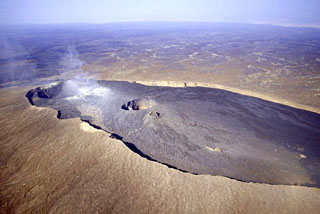Report on Erta Ale (Ethiopia) — September 2005
Bulletin of the Global Volcanism Network, vol. 30, no. 9 (September 2005)
Managing Editor: Richard Wunderman.
Erta Ale (Ethiopia) Agitated lava lake during time of September 2005 earthquake swarm ~ 100 km S
Please cite this report as:
Global Volcanism Program, 2005. Report on Erta Ale (Ethiopia) (Wunderman, R., ed.). Bulletin of the Global Volcanism Network, 30:9. Smithsonian Institution. https://doi.org/10.5479/si.GVP.BGVN200509-221080
Erta Ale
Ethiopia
13.601°N, 40.666°E; summit elev. 585 m
All times are local (unless otherwise noted)
In conjunction with their investigation of eruptive activity related to a swarm of earthquakes at Dabbahu/Boina, a team of geologists from Addis Ababa University (AAU) also undertook field observations at Erta Ale, with the aid of a military helicopter (see map in this issue of BGVN, the report on Dabbahu/Boina). What follows is their report combined with other information they gathered.
Between 21 and 24 September 2005, the local people saw, from a distance, red and glowing light shooting and rising into the air above Erta Ale. This was an indication that a Strombolian eruption probably occurred, emitting a significant volume of fresh magma within and possibly out of the pit.
The AAU team surveyed Erta Ale's craters at about 0930 on 26 September from the helicopter, as landing was not possible. Within the small southern pit crater of the main crater, they observed a new cone-shaped construct and the presence of an actively convecting lava lake in the center of the new cone. The lava lake occupied the entire lower/inner pit with hot red lava visibly overturning at the edges of the pit. Molten lava was breaking through the lake's solidified black crust. In the northern pit crater, there was a conspicuous solidified lava bulge with dark emissions along the crater walls. No incandescent lava was visible in this pit.
In addition to their direct observations, the AAU team studied videos taken by Walta Information Center of the southern pit on November 2004 and 26 September 2005. The comparison revealed significant changes, particularly in the morphology and activity of the southern pit crater. In the later videos the main crater/pit had widened significantly, with portions of the earlier crater walls having collapsed into the lava lake. There was a new cone-shaped construct within the crater in place of the previous platform that existed between the rim of the outer crater/pit and the lower pit. The new cone was estimated to be some 20 to 30 m from the top of the crater rim. The new cone apparently contained layers of basaltic scoria covered by fresh lava flows. The combined thickness of tephra and lava was estimated to be 20 to 30 m. The lava lake occupied the entire width of the inner crater/pit and was then bounded by steep sides. The lake's surface stood 20 to 30 m below the cone's top.
Anthony Philpotts accompanied Gezahegn Yirgu and colleagues from Addis Ababa University faculty on a helicopter visit to Erta Ale on 15 October. They found the lava lake incredibly active, much more so than when filmed by earlier visitors in March 2005.
A brief review of satellite thermal anomaly data from MODIS/MODVOLC revealed an absence of thermal activity between 12 October 2004 and 31 March 2005, with a renewal beginning on 31 March 2005, increasing substantially in mid-2005 and continuing vigorously through at least 2 November 2005.
Geological Summary. The Erta Ale basaltic shield volcano in Ethiopia has a 50-km-wide edifice that rises more than 600 m from below sea level in the Danakil depression. The volcano includes a 0.7 x 1.6 km summit crater hosting steep-sided pit craters. Another larger 1.8 x 3.1 km wide depression elongated parallel to the trend of the Erta Ale range is located SE of the summit and is bounded by curvilinear fault scarps on the SE side. Basaltic lava flows from these fissures have poured into the caldera and locally overflowed its rim. The summit caldera usually also holds at least one long-term lava lake that has been active since at least 1967, and possibly since 1906. Recent fissure eruptions have occurred on the N flank.
Information Contacts: Gezahegn Yirgu, Department of Earth Sciences, Addis Ababa University, P.O. Box: 1176, Addis Ababa, Ethiopia; Walta Information Centre, Woreda Kirkos, Kebele 05, House No. 095, PO Box 12918, Addis Ababa, Ethiopia (URL: http://www.waltainfo.com/); Anthony Philpotts, University of Connecticut, U-45, Beach Hall, Storrs, CT 06269, USA; MODIS/MODVOLC Thermal Alerts Team, Hawaii Institute of Geophysics and Planetology (HIGP), University of Hawaii, 2525 Correa Road, Honolulu, HI 96822, USA (URL: http://modis.higp.hawaii.edu/).

